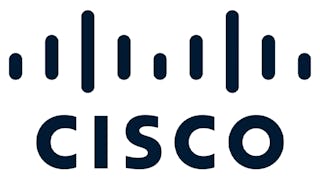Elevate your network expertise with this comprehensive course on VPN principles and MPLS VPN architecture. You'll gain an in-depth understanding of VPNs—why they were created, the essential terminology, and how overlay and peer-to-peer models differ in implementation, benefits, and challenges. The curriculum moves beyond the basics to unravel the unique components and layered structure of MPLS VPNs, including route distinguishers (RDs), route targets (RTs), virtual routing tables, and address propagation.



Examining MPLS VPN Operation
This course is part of Implementing Cisco MPLS Specialization

Instructor: Cisco Learning & Certifications
Access provided by Universidad Austral
What you'll learn
Identify the major terminology and topology of VPNs
Describe the major architectural components and routing requirements of an MPLS VPN
Describe how packets are forwarded in an MPLS VPN environment
Skills you'll gain
Details to know

Add to your LinkedIn profile
33 assignments
July 2025
See how employees at top companies are mastering in-demand skills

Build your subject-matter expertise
- Learn new concepts from industry experts
- Gain a foundational understanding of a subject or tool
- Develop job-relevant skills with hands-on projects
- Earn a shareable career certificate

There are 5 modules in this course
What's included
2 readings
This course explains the concept of VPNs as well as the VPN terminology that is also used by the MPLS VPN architecture. The course looks at why VPNs were first introduced; the course also explains the differences between the overlay and peer-to-peer VPN models, how they are implemented, and the benefits and drawbacks of each implementation. It is important to understand the background of VPNs, because you should be able to determine when an organization might need a VPN, and be able to explain how MPLS VPNs can help save time and money. Understanding the different types of VPNs will allow you to recognize where the various types of VPNs would be best used in their associated networks.
What's included
5 videos7 readings7 assignments
This course explains the MPLS VPN architecture, route information propagation, RDs, RTs, and virtual routing tables. It is important to understand how the MPLS VPN architecture is structured, what the components of that architecture are, and how the components are used. This knowledge will help later when you begin to look at design issues and configuration parameters.
What's included
9 videos12 readings12 assignments
This course explains the routing requirements for MPLS VPNs. The course offers address and routing perspectives from the customer and service provider side, and it discusses how routing tables appear on PE routers. This lesson also discusses MPLS VPN end-to-end information flow, MP-BGP, updates, and display formats. It is important to understand how information is routed in an MPLS VPN, and how the routing tables are viewed and interpreted. This course will help you to get a clear understanding of the similarities and differences between the global routing table and the virtual routing tables that are created in an MPLS VPN.
What's included
5 videos8 readings8 assignments
This course explains how forwarding across an MPLS VPN backbone occurs, identifies how labels get propagated, and explains the effects of summarization in the core. It is important to understand how packets are forwarded across an MPLS VPN backbone, because this understanding will help you when you try to isolate problems in the network. This course explains how the far-end label is sent to the ingress PE router and how that information is shared.
What's included
5 videos6 readings6 assignments
Earn a career certificate
Add this credential to your LinkedIn profile, resume, or CV. Share it on social media and in your performance review.
Instructor

Offered by
Why people choose Coursera for their career




Explore more from Information Technology

Cisco Learning and Certifications

Cisco Learning and Certifications

Cisco Learning and Certifications

Cisco Learning and Certifications

